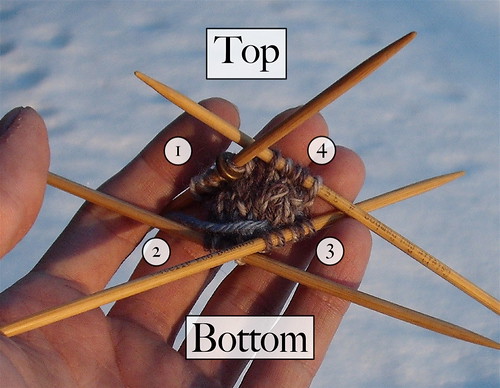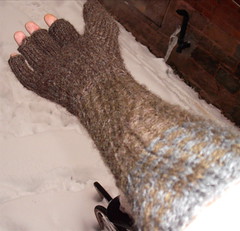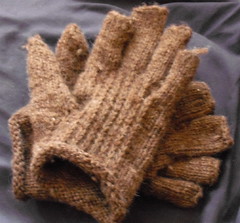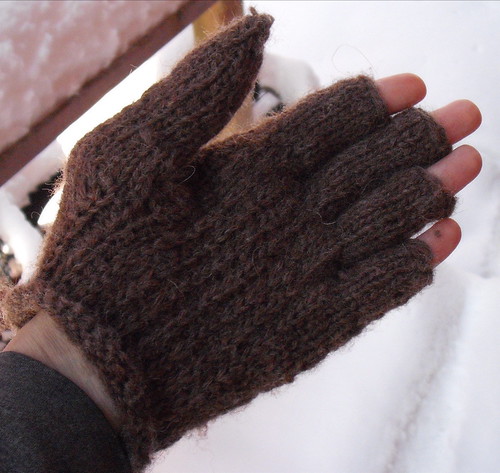|
|
|
A few days ago, I was approached by colorlessblue. She had a pretty sock pattern made up of triangles, but it required her to use exactly 64 stitches around.
Her difficulty was that she couldn't find a gauge in which that worked. Me first reaction was to say, "well, that's not a big deal, the pattern is trivial to make fit on a multiple of 12 or 14 stitches." Then I tried to explain what stitches to remove, and it really quickly became messy.
So I stopped for 15 minutes or so and drew a few patterns. As I started, she clarified that she didn't want to purl.
This is what resulted:


However, the absence of purl stitches meant that the resulting pattern would be triangles of vertical knit stitches with a zigzag border of slanted stitches. So, my next thought was, "Why not make the slanted stitches into the motif. That resulted in this pattern:
 It's not perfect by any means. The k2tog and SSK being next to each other results in a ladder. Were I continuing that tangent, I'd turn all paired decreases into double decreases. Also, as it turns out, I didn't like how the paired yarn overs at the apex of the triangle looked.
At the same time as I was thinking that, I also wondered what would happen if the triangles were offset by half a repeat, giving the whole pattern a longer period before it repeats.
It's not perfect by any means. The k2tog and SSK being next to each other results in a ladder. Were I continuing that tangent, I'd turn all paired decreases into double decreases. Also, as it turns out, I didn't like how the paired yarn overs at the apex of the triangle looked.
At the same time as I was thinking that, I also wondered what would happen if the triangles were offset by half a repeat, giving the whole pattern a longer period before it repeats.

This pattern (which is almost the same as a Barbara Walker one) has the property that the knit stitches actually form themselves into vein-like curves: the diamonds end up looking like oval leaves.
I tried knitting it half in knit and half in purl, to see if that would give the leaves more shape, but that ended up being a step too far: The lace lost enough of its definition that the pattern looked awkward and no longer anything like leaves.
I think I'm likely to use this one at some point, possibly as a motif one some leaf-patterned socks that I keep not getting around to. Before I do, I'm likely to put it through one more mutation, reducing it to about half the size and extending the widest part of the leaf by two rows, so that it more accurately matches the shape of a beech leaf.
Most of my charts seem to follow a similar pattern of starting point and progressive mutation, followed by a test knit, correction of discovered problems, a further test knit and possibly correcting steps that went too far.
It's like saying "just one more row", but "just one more change" instead.
Someday, I'm going to learn to knit tiny swatches. The first one I did for this hat was enormous, the size of a tea towel, but highlighted more than a few mistakes that I was making.
Luckily, the cable pattern is composed of repeated motifs. So, seeing these motifs work once was enough to know how they work throughout.
Unfortunately, my first sketch for the lace pattern was done somewhat foolishly. I believed that I could guess, from the pattern, what it would look like, conveniently forgetting that lace isn't just a pattern of holes: it also relies on a structure of slanted and upright stitches.
What I'm trying to say is that my first sketch was uglier than ugly. I've revised it now, and on paper, it looks nice. In practice, I don't know. So I'm doing the sensible thing this time and knitting it again.
There needs to be a pattern to the decreases anyhow, and I've no idea what that'll be. Thus, he sensible thing is 30 rows of swatch, a lifeline and then some puzzling out what decreases go where.

I've made a little change to the instructions: In decreasing the ribbing, I said to p1, s1, psso. That's not really possible. I meant to say s1, p1, psso.
Also, I noticed that the pattern was written with my old method of typing stitches into a spreadsheet. Since then, I've set up Inkscape with a template SVG document that does a far far better job at giving me good-looking knitting patterns.
So, while updating the PDF for the dogwood cabled hat, I added in a proper graphical pattern, which looks far far prettier than the previous ASCII-art one.
Well, I've ripped these things three times. One because I realised that I wanted to do the toe in heel stitch. Two because circular heel stitch while increasing is harder than I thought.
So, in the interests of not ripping a fourth time, I'm going to write out one full repeat of the heel stitch-while-increasing pattern.
It uses the needle numbering I've used elsewhere, where the two needles on top are 1 and 4, and the ones on the bottom are 2 and 3.

Heel Stitch Toe
First, knit four rows from a provisional cast on of 8 stitches and divide the 16 stitches between four needles. You'll be on needle 4, so knit that needle to get to needle 1.
- Knit the entire round.
- Needle 1: k2, kfb, k1 (5)
Needle 2: k1, kfb, k2 (5)
Needle 3: k2, kfb, k1 (5)
Needle 4: k1, kfb, k2 (5)
- Needle 1: k1, s1 wyib, k3
Needle 2: k3, s1 wyib,, k1
Needle 3: s1 wyib, k1, s1 wyib, k2
Needle 4: k2, s1 wyib, k1, s1 wyib
- Needle 1: k3, kfb, k1 (6)
Needle 2: k1, kfb, k3 (6)
Needle 3: k5
Needle 4: k5
- Needle 1: k1, s1 wyib, k1, s1 wyib, k2
Needle 2: k2, s1 wyib, k1, s1 wyib, k1
Needle 3: s1 wyib, k1, s1 wyib, k2
Needle 4: k2, s1 wyib, k1, s1 wyib
- Needle 1: k4, kfb, k1 (7)
Needle 2: k1, kfb, k4 (7)
Needle 3: k3, kfb, k1 (6)
Needle 4: k1, kfb, k3 (6)
- Needle 1: k1, s1 wyib, k1, s1 wyib, k3
Needle 2: k3, s1 wyib, k1, s1 wyib, k1
Needle 3: s1 wyib, k1, s1 wyib, k3
Needle 4: k3, s1 wyib, k1, s1 wyib
- Needle 1: k5, kfb, k1 (8)
Needle 2: k1, kfb, k5 (8)
Needle 3: k6
Needle 4: k6
- Needle 1: k1, s1 wyib, k1, s1 wyib, k1, s1 wyib, k2
Needle 2: k2, s1 wyib, k1, s1 wyib, k1, s1 wyib, k1
Needle 3: s1 wyib, k1, s1 wyib, k3
Needle 4: k3, s1 wyib, k1, s1 wyib
The rules are:
- Knit on increase rows.
- Needle 1 starts on a knit stitch.
- The last two stitches on the needle are never slipped, otherwise you get holes.
- Needle 2 is needle 1 knit backwards (ends on a knit stitch).
- Needle 3 starts on a slip stitch.
- Needle 4 is needle 3 knit backwards (ends on a slip stitch).
I think, when I write this pattern out in full, that I'll write it from 4 stitches on each needle through to 60 stitches around, simply because it's not a pattern that follows easily.
ETA (7/2/2009): I've considered and toyed with this pattern more since noting it down, and the correct answer is that I'm numbering the needles wrong. Realistically, 1 and 2 should be the top of the foot, 3 and 4 the bottom.

I worked that out when trying to chart the pattern and not wanting to either write a chart with directions like "start at the middle, read right to left for needle 1, read left to right for needle 2 and 3, then right http://www.blogger.com/img/blank.gifto left for needle 4, stopping at the middle" or to write a separate pattern for each needle.
By changing how I thought of the needles, I was able to write a single chart for the top and the bottom, presented as two charts, as the bottom is the enantiomer of the top.

Deliberately, this chart goes on past what I reasonably expect as sizes, just to avoid having to try to give the extrapolation of the pattern as a process, as the algorithm for generating the toe relies somewhat on anticipating the next line.
I've worn the Joy of Cables Hat for a few days now, and am finding that my fear of running out of yarn made for a hat that was a little too shallow. It just covers my ears and does so loosely.
Fortunately, I have plenty of yarn in other colours, so I'm going to extend the hat by 5cm or so. The edge is a simple k2p2 rib, so what I'll do is pick up stitches, purl one row to give the hat a line where it'll fold easily, then knit a brim in the same rib.
Because I'm trying to tighten the hat a bit as well, I'll keep the rib the same. Were it already a snug fit, I'd increase on rows 4 and 8, in the purl part of the ribbing.
The hat was knit on 5mm needles, so I'll pick up with much smaller needles. The closest smallercircular needles at hand were 3.5mm, so I'm using those. Picking up stitches is a simple enough prospect: there's a hole just right of each stitch, so I insert a needle under both threads of the cast on, insert the point of my circular needle and knit a stitch. Then I repeat that 120 times, one per stitch.
After that, I'll knit from the 3.5mm needles onto 6mm ones, as that was the size used for the hat.

I have knit the right sleeve now. To fit my arm, it took a total of 68 rounds on 5mm DPNs. As well, to work the increases that were necessary to making the sleeve taper outward, I chose a style of increase that fit the pattern.
- Starting at the beginning of a rib, k3, p1, purl the front of the next stitch then knit the back (pfb). (6 stitches)
- k1, s1, k1, p3
- k2, p1, knit the front loop, then the back, of the next stitch (kfb), p1 (7 stitches)
- k1, s1, k1, p1, k2, p1
- k3, pfb, k2, pfb (9 stitches)
- k1, s1, k1, p2, k2, p2
- k3, p2, k1, kfb, p2 (10 stitches)
- k1, s1, k1, p2, k1, s1, k1, p2
- k3, p2, k3, p2
At this point, another rib has been added, appearing as a line of knit stitches in the middle of a column of purl stitches.
I did this twice, once after knitting 30 rounds and again after knitting 50. This allowed me to keep the glove tight around the wrist, flaring slightly as it approached my elbow.
Because I like the zigzag that the ribbing pattern gives, I alternated green and brown yarns for the majority of it, ending the upper sleeve with a change to green and grey for ten rounds each.

I've now knitted one pair of Janis Cortese's Broad Street Mittens in worsted yarn. They fit nicely, but, unfortunately, only come to my wrist as I've not yet started knitting the cuff/sleeve.
I want the sleeve to be at least 30 cm, so left it out of knitting the mittens until I saw how they turned out. Though, I suppose that I could have started with the sleeve and converted it into arm warmers after the fact.
I know that the current cuff of the mittens is 40 stitches around. I also know that my wrist is tiny, so what I intend to do is reduce to 30 stitches around (I pulled the cuff of the glove tight and counted the number of stitches around my wrist) and then add 5 stitches halfway up my arm.
Why 5? Well, I've found myself knitting a lot of k2p2 rib recently, so want to do something different, especially seeing as it looks serviceable but ultimately uninteresting when worked in multiple colours. I have a nice olive drab yarn that I bought when I was first considering these mittens, and I'd like the sleeves to be striped.
With those two constraints in mind, I considered various ribbings and decided that I'd work the following pattern:
- knit 1, slip 1 purlwise with yarn in back, knit 1, purl 2 (repeat from start)
- knit 3, purl 2 (repeat from start)
That way, the slipped stitches break the monotony of simple circular stripes, forming a slight wave pattern with the purl stitches, while still providing the texture and stretchiness of ribbing.
The final consideration is what gauge to use. I'd considered knitting the sleeve on 3.75mm needles, but gradually decided that, since it's a layer that will be worn along with a shirt and coat, that I might be wise to use 5mm needles to get a looser fabric. That means that, rather than using 30 stitches as I'd intended, I'll need to use fewer.
My gauge on the gloves was 8 stitches / inch and my gauge on the 5mm needles with worsted yarn is 5 stitches/inch. From there, it's simple algebra to figure out how many I need:
desired stitches / 30 == 5 st/in / 8 st/in
desired stitches == ( 5 / 8 ) * 30
desired stitches = 18.75
Since the pattern I'm using for the ribbing is a repeat of 5 stitches, I round 18.75 to 20 and know that I need to decrease half the stitches to make it fit. In order to keep the glove from puffing out, I'm going to try picking up 40 stitches then decreasing ten of them the next row, knitting one row straight, then decreasing ten times on the next row.
If that doesn't work, I'll rip it out, pick up and knit a round with 3.75mm needles, decrease to 30 stitches and then knit onto the 5mm needles.
A note, though: to keep the fabric from stretching as I pick up, that will be done on 3.75mm needles and the second round will be knit onto the 5mm ones.

I'm currently knitting Janis Cortese's lovely Broad Street mittens, from the fall 2002 issue of Knitty. In looking over the pattern, I decided to make a few adjustments in the interest of warmth.
This is not a pattern so much as it is a list of modifications to the Broad Street pattern.
Firstly, the pattern is meant to be knit with small needles and fingering-weight wool. I decided that I wanted worsted wool, partly for warmth and partly because, when contemplating the pattern, I bought two balls of worsted in preparation.
In what could be considered a moderately silly gauge swatch, I knit the palm, following the pattern. Then, comparing the half-glove hat I had to the size of my hand, I worked out that it was about 50% too big.
I cast on again, starting from the wrist as before. This time, knowing the difference in size, I used 40 stitches of worsted weight on 3.75 mm needles, for a tight, dense fabric. The reason for starting at the wrist rather than the cuff is that I'm planning to knit elbow-length sleeves onto the gloves, so will pick up around the wrist and knit until I'm satisfied.
I knit two rows before getting to my second change: rather than knitting the palm in stockingette, I want it to be a thicker, denser fabric. A quick browse of Barbara Walker's Treasury of Knitting Patterns gave me k1s1 rib, or heel stitch.
Thus the pattern for the palm became:
- knit the whole round
- knit the whole round
- k2, *k1, slip one stitch purlwise with the yarn in back, repeat from * until the second-last stitch on the second needle. p1, knit the last stith front and back. Knit the rest of the round.
- knit the whole round
- k2, *k1, sl1 wyib, repeat from * until reaching the purled stitch. p1, kfb. Knit the rest of the round.
- knit the whole round.
I repeated steps 5 and 6 until I'd added eight stitches, set those stitches aside and cast on nine stitches on the next row.
For the thumb gusset decrease, I used the SSK/k2tog decrease until I again had ten stitches on the second needle.
To finish the palm, I knit 12 rows with heel stitch on the palm, stockingette on the back. The glove is longer lengthwise because the heel stitch used makes a far denser fabric vertically. Also, my hands are very long. Following the pattern, 8 rows would be more accurate.
Pinky finger was 4 from the palm, 5 from the back, plus one cast-on stitch.
Extending the palm, I picked up 3 stitches from the pinky, rather than 2, to ensure no holes. Knit 8 rounds, heel stitch on the front, stst on the back.
The other fingers were 12 stitches, 16 stitches and 16 stitches, using 3 stitches picked up from the finger beside them each time.
For the thumb, I picked up 12 stitches from the cast-on stitches and immediately decreased from 22 to 18, at a rate of two decreases every other row. The thumb was finished in the same way as described in the pattern.
|
|
 It's not perfect by any means. The k2tog and SSK being next to each other results in a ladder. Were I continuing that tangent, I'd turn all paired decreases into double decreases. Also, as it turns out, I didn't like how the paired yarn overs at the apex of the triangle looked.
At the same time as I was thinking that, I also wondered what would happen if the triangles were offset by half a repeat, giving the whole pattern a longer period before it repeats.
It's not perfect by any means. The k2tog and SSK being next to each other results in a ladder. Were I continuing that tangent, I'd turn all paired decreases into double decreases. Also, as it turns out, I didn't like how the paired yarn overs at the apex of the triangle looked.
At the same time as I was thinking that, I also wondered what would happen if the triangles were offset by half a repeat, giving the whole pattern a longer period before it repeats.


















